
|
Chandragupta II was probably a younger son of Samudragupta, who succeeded his father over his older brother Ramagupta, either because of his father's choice,
or through force of arms. There is some evidence of trouble between the two brothers and of Chandragupta having put his brother to death.
Chandragupta further expanded the empire he inherited from his father. Notably, he defeated the Western Kshatrapa king, Rudrasimha III and annexed the Western
Kshatrapa lands to the Gupta empire. Numismatic evidence of this conquest is seen in Chandragupta's issuance of the first Gupta silver coins based on Western Kshatrapa
designs. He also issued copper and lead coins. He reigned c. 375-414.
|
| Gold Coins |
Archer type |
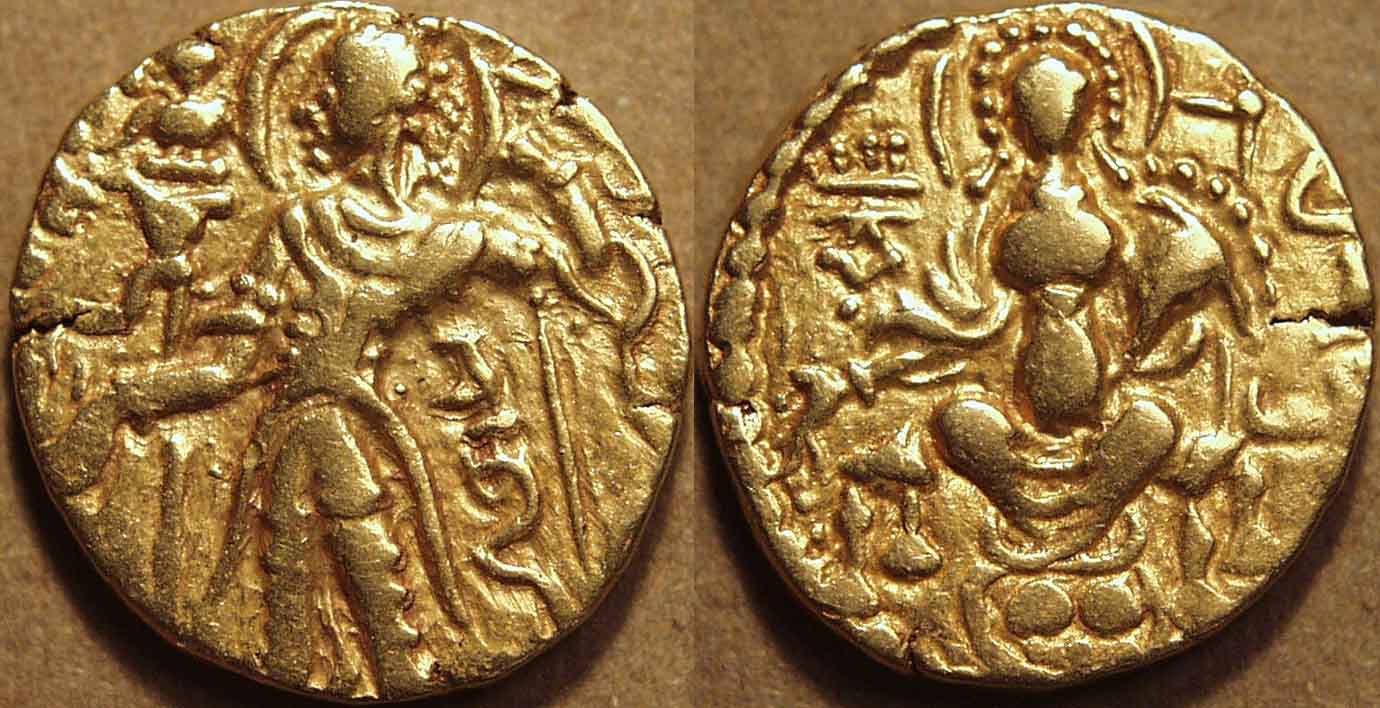
|
Chandragupta II, gold dinar, c. 375-414
Weight: 7.81 gm, Diameter: 18 mm.
King standing left, holding an Indian long bow in his left hand and an arrow in his right
Garuda standard at left, Brāhmī legend under arm: Chandra
circular Brāhmī legend around /
Lakshmi enthroned facing, holding cornucopia in left arm, with right hand in varadamudra,
dispensing coins, Brāhmī legend at right: Sri Vikramah
|
 |
The archer type is the most common type of Chandragupta II, but it comes in a wide range of varieties, some of which
are illustrated in the group here. Perhaps the earliest group, to which this coin belongs, continued to depict Lakshmi seated on a throne as on Samudragupta's sceptre and
archer types. The present coin is a basic type in which the only object in the left obverse field is the Garudadhvaja, and the king's name is under the arm
to the left of the bow string. Note how the throne back is depicted by a line at right, with another horizontal line at top right.
|
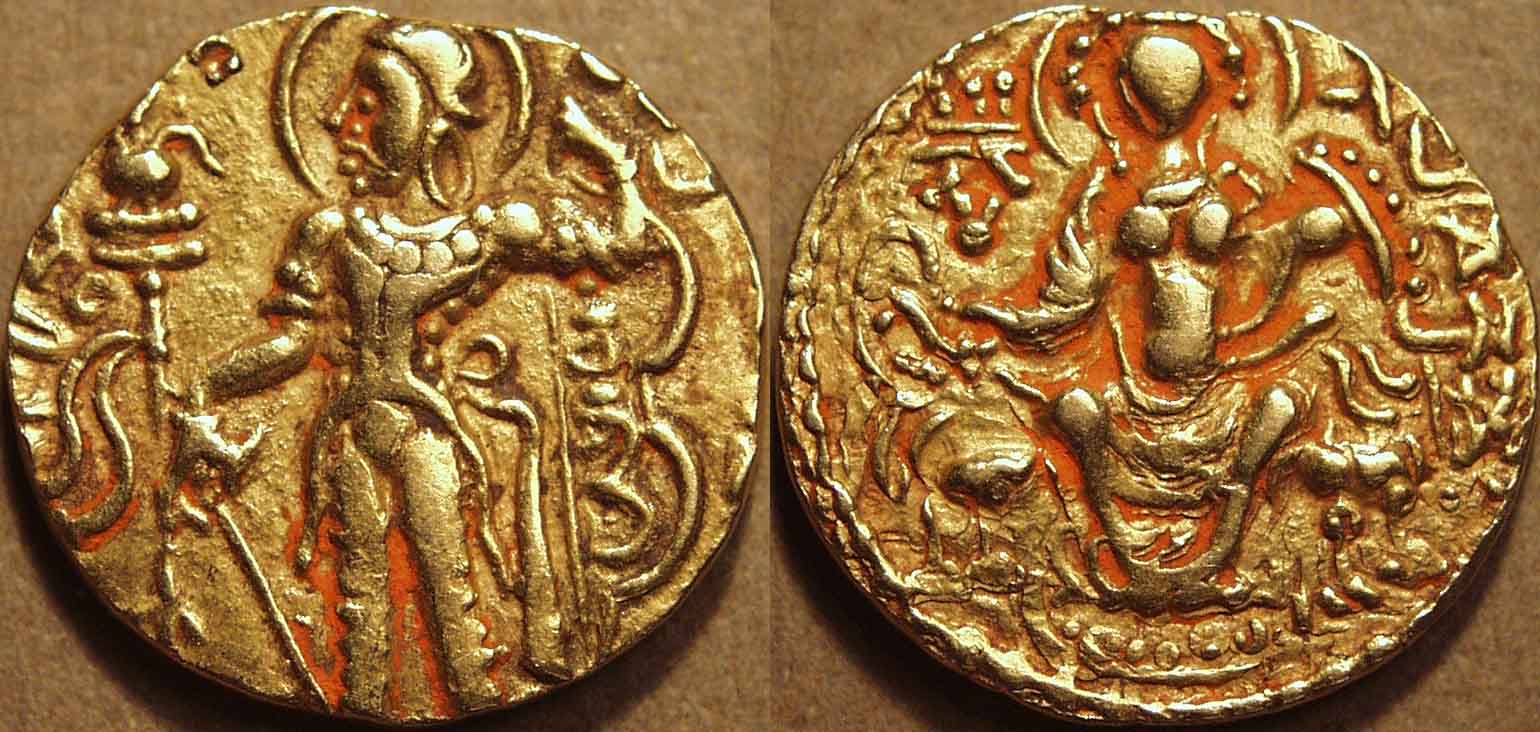
|
Chandragupta II, gold dinar, c. 375-414
Weight: 7.76 gm, Diameter: 20 mm.
King standing left, holding an Indian long bow in his left hand and an arrow in his right
Garuda standard at left, Brāhmī legend under arm between the bow
and bowstring: Chandra, circular Brāhmī legend around /
Lakshmi enthroned facing, holding cornucopia and diadem,
Brāhmī legend at right: Sri Vikramah
|
 |
On this variety, the king's name has migrated from its normal position to the left of the bow to a position between the bow
and the bowstring. Here the throne back is represented only by two short lines at right angles in the top right. |
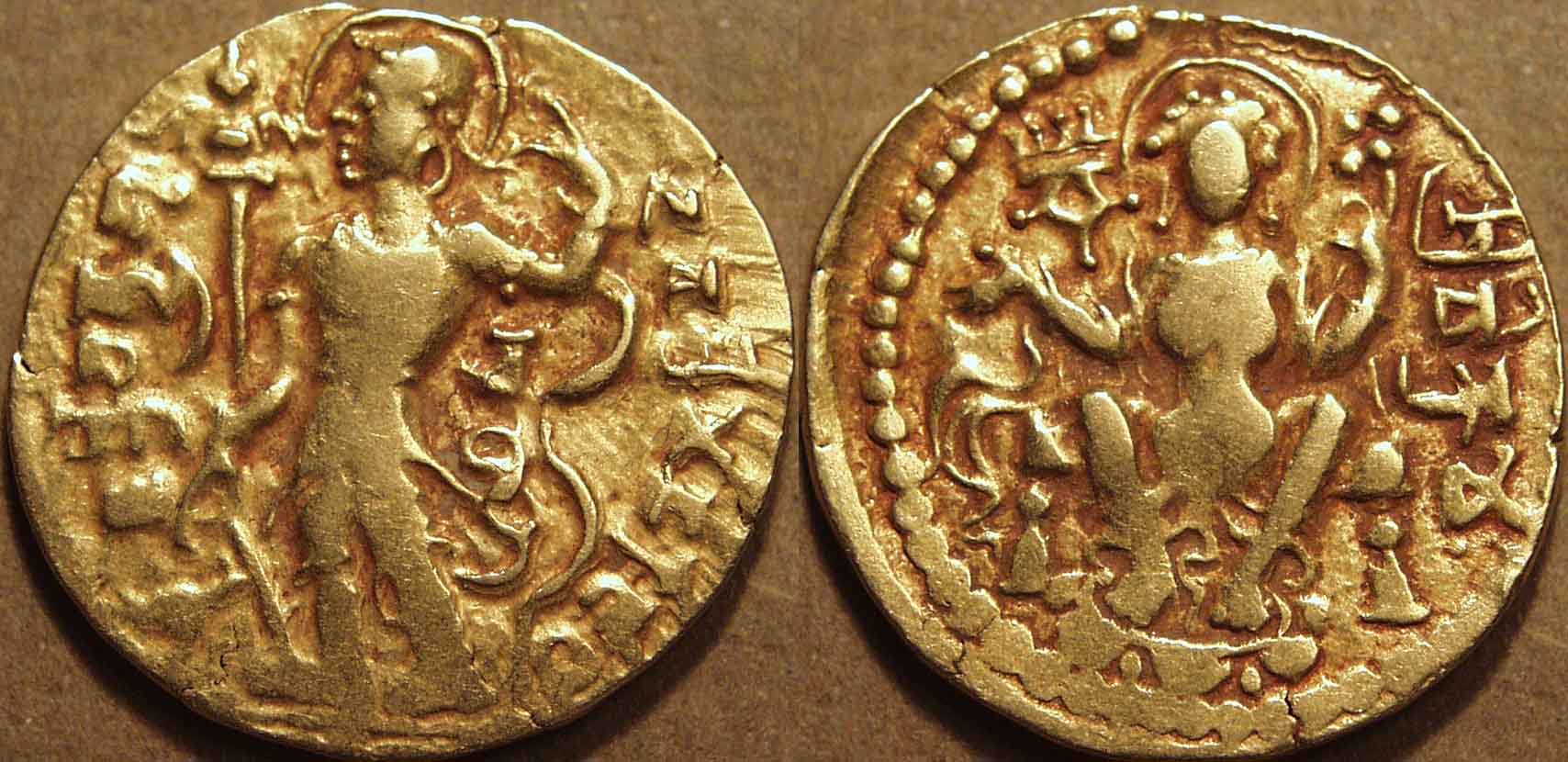
|
Chandragupta II, gold dinar, c. 375-414
Weight: 7.88 gm, Diameter: 22 mm.
King standing left, holding an Indian long bow in his left hand and an arrow in his right
Garuda standard at left, Brāhmī legend under arm between the bow
and bowstring: Chandra, circular Brāhmī legend around /
Lakshmi enthroned facing, holding lotus blossom and diadem,
Brāhmī legend at right: Sri Vikramah
|
 |
This variety seems to be a cross between the first two ... the bowstring has disappeared and the king's name has taken
its place. Also, the throne back has completely disappeared, and the cornucopia that Lakshmi used to hold in her (proper) left arm has been replaced by a long-stemmed lotus
blossom. Lakshmi retains this attribute in all subsequent coins. |
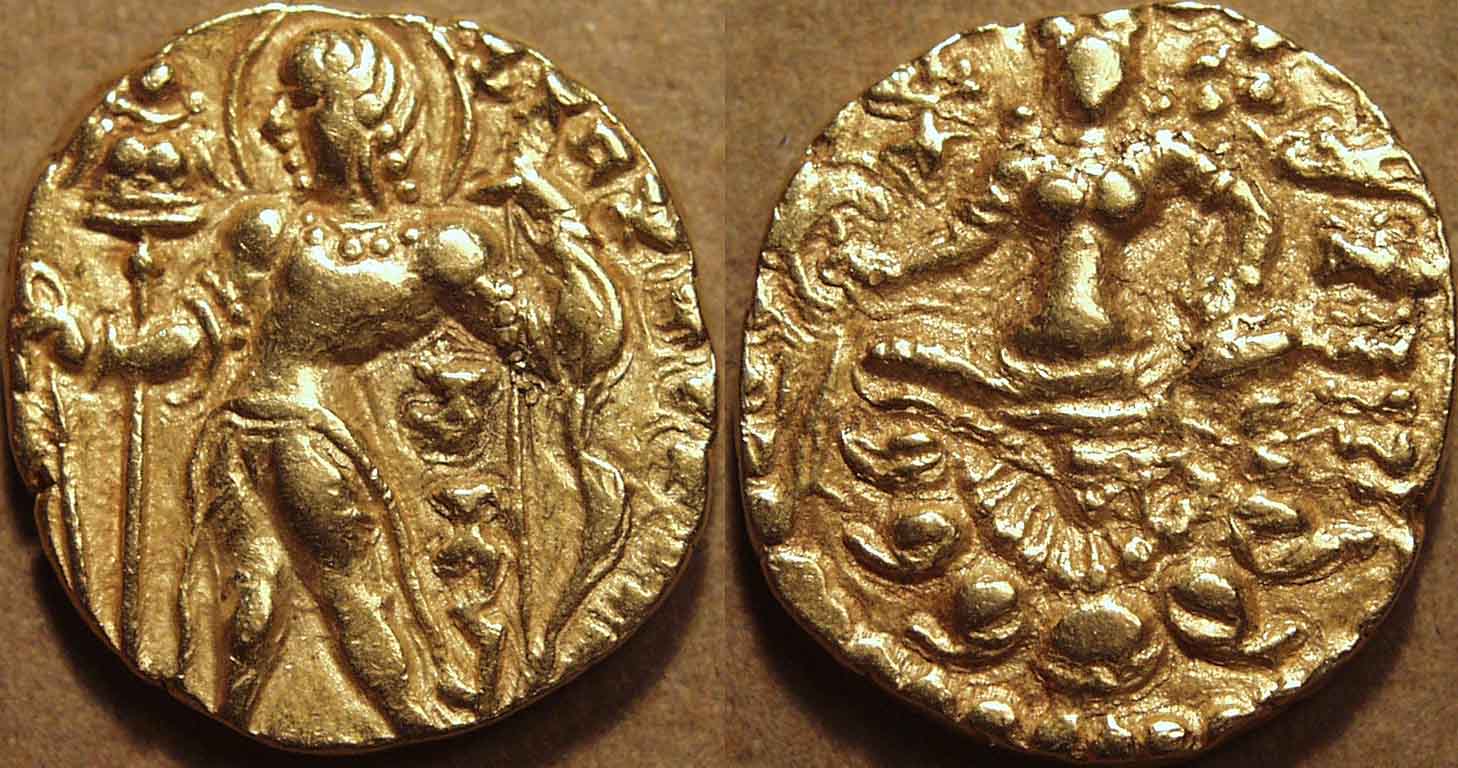
|
Chandragupta II, gold dinar, c. 375-414
Weight: 7.91 gm, Diameter: 19 mm.
King standing left, holding an Indian long bow in his left hand and an arrow in his right
Garuda standard at left, Brāhmī legend under arm: Chandra
circular Brāhmī legend around /
Lakshmi seated facing on a stylized lotus in padmasana, holding lotus blossom and diadem,
Brāhmī legend at right: Sri Vikramah
|
 |
At some point, the throne on which Lakshmi was seated was eliminated and was replaced by a lotus seat, such
as on the present coin, where Lakshmi is seated on a stylized lotus spread out below her. |

|
Chandragupta II, gold dinar, c. 375-414
Weight: 8.20 gm, Diameter: 20 mm.
King standing left, holding an Indian long bow in his left hand and an arrow in his right,
sword at his hip, Garuda standard at left, Brāhmī legend under arm: Chandra
circular Brāhmī legend around /
Lakshmi seated facing on a stylized lotus in padmasana, holding lotus blossom and diadem,
Brāhmī legend at right: Sri Vikramah
|
 |
On this variety, the king wears a sword at his hip. |
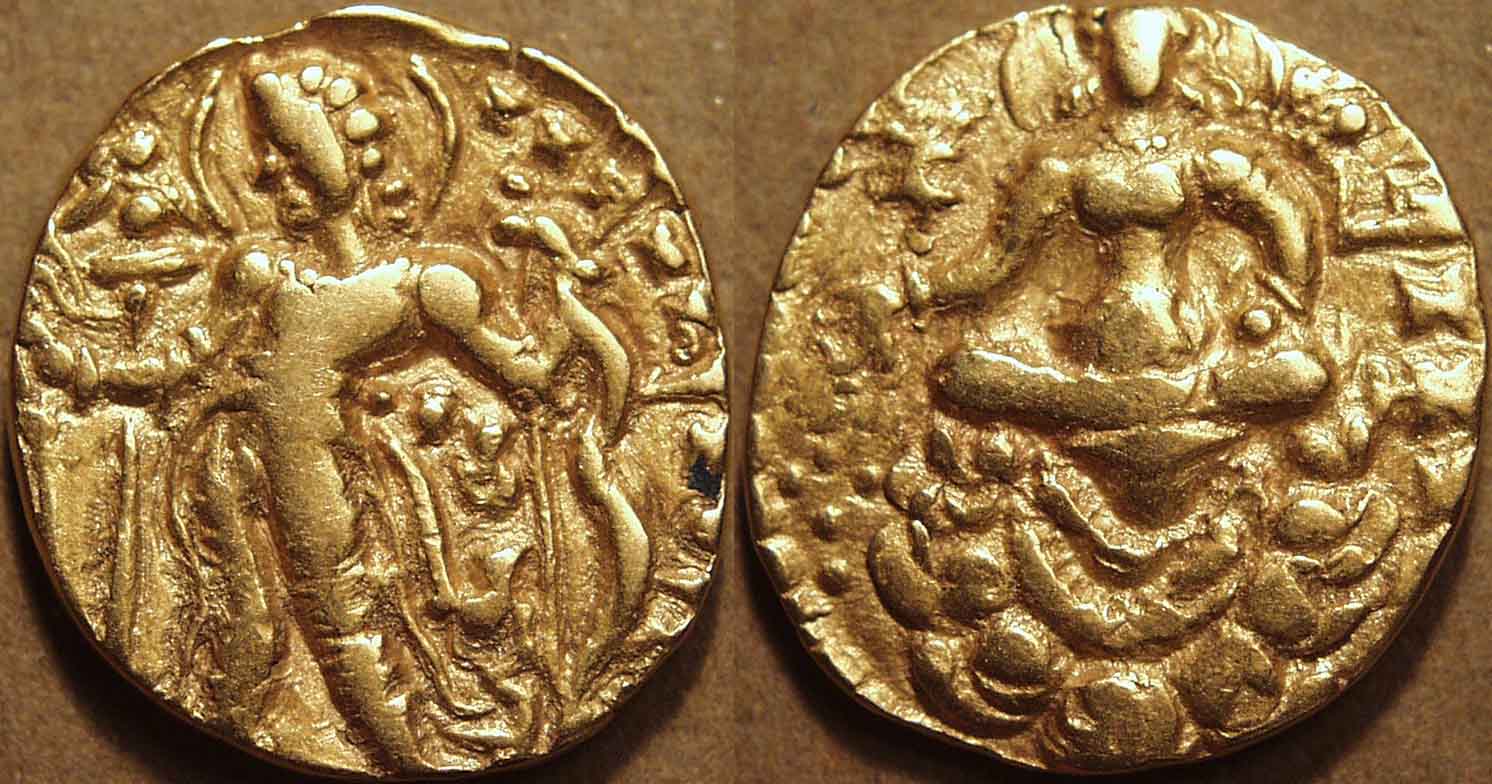
|
Chandragupta II, gold dinar, c. 375-414
Weight: 8.03 gm, Diameter: 19-20 mm.
King standing left, holding an Indian long bow in his left hand and an arrow in his right,
Garuda standard at left, Brāhmī legend under arm: Chandra
circular Brāhmī legend around /
Lakshmi seated facing on a stylized lotus in padmasana, holding lotus blossom
and scattering coins, Brāhmī legend at right: Sri Vikramah
|
 |
On this remarkable variety, the goddess Lakshmi, instead of holding a diadem in her right hand, is scattering coins with
that hand. This is an aspect of Lakshmi , as granter of wealth, that is very prominent in modern Indian iconography.. |
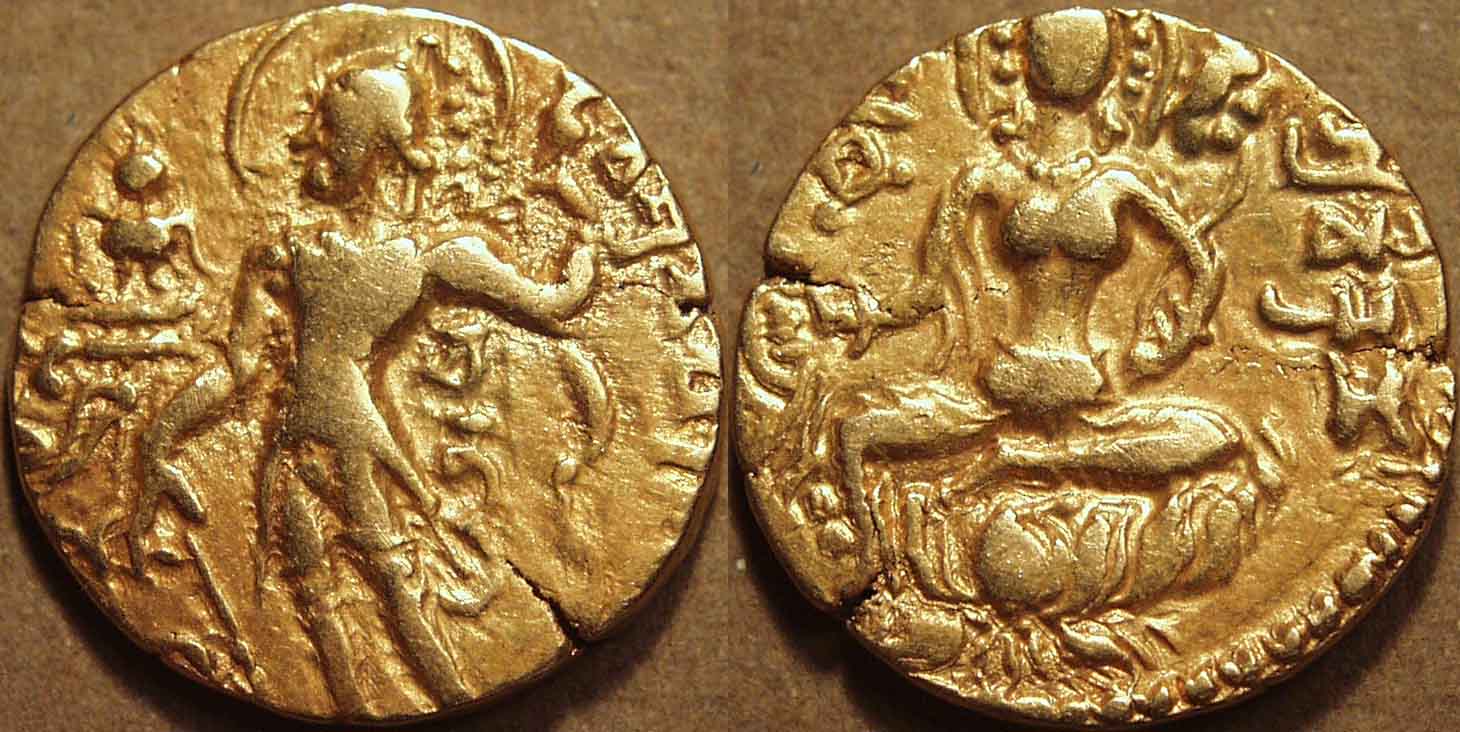
|
Chandragupta II, gold dinar, c. 375-414
Weight: 7.73 gm, Diameter: 19 mm.
King standing left, holding an Indian long bow in his left hand and an arrow in his right,
Garuda standard at left, Brāhmī legend under arm: Chandra
circular Brāhmī legend around /
Lakshmi seated facing on a profile lotus in padmasana, holding lotus blossom and diadem,
Brāhmī legend at right: Sri Vikramah
|
 |
On this coin, Lakshmi's seat is a realistic lotus in profile rather than the stylized bloom normally spread out below her like
a carpet. Here, the Goddess sits at ease in lalitasana, with one leg hanging down from her raised lotus seat. |
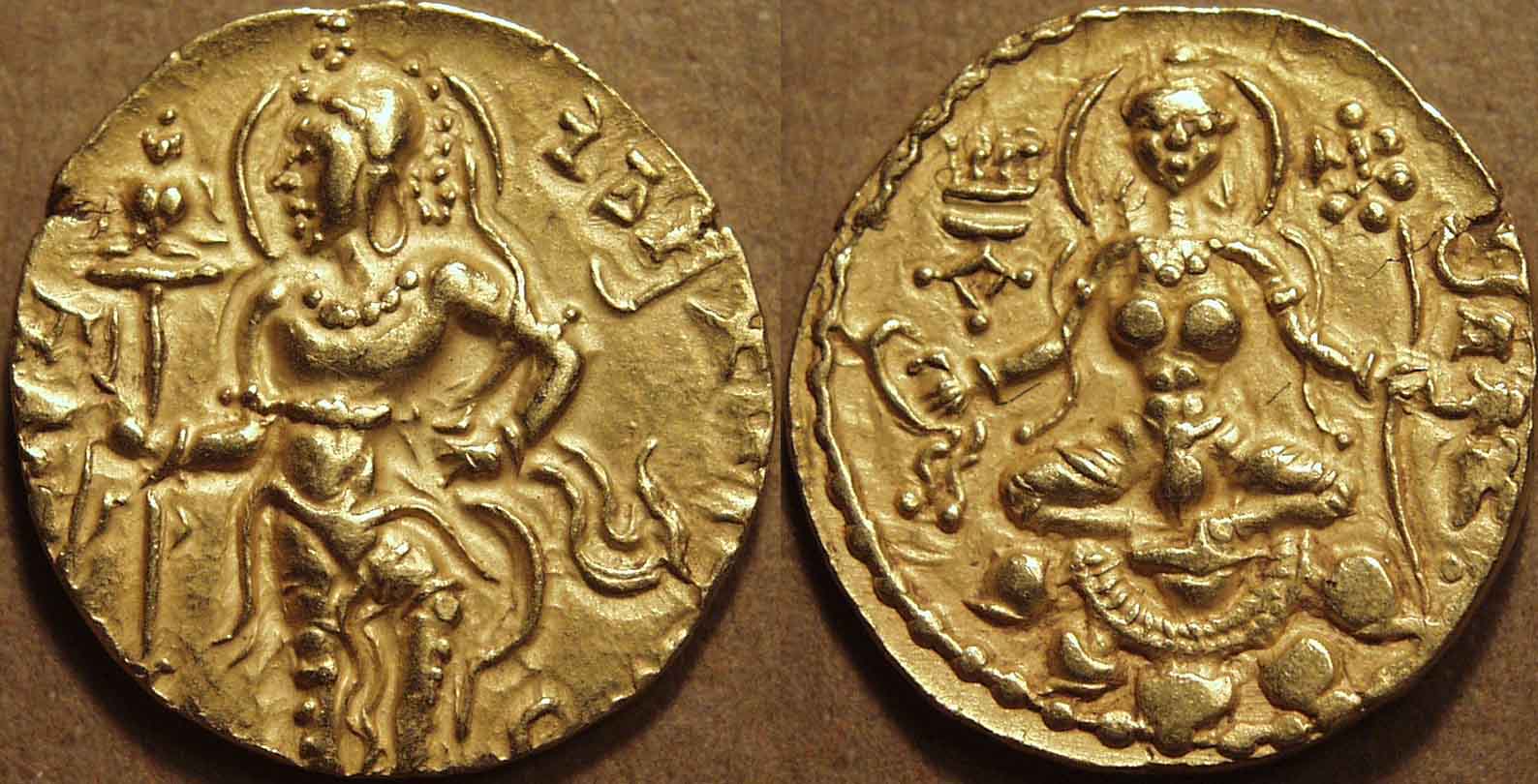
|
Chandragupta II, gold dinar, c. 375-414
Weight: 7.73 gm, Diameter: 21 mm.
King standing left, holding an Indian long bow in his left hand and an arrow in his right
Garuda standard at left, circular Brāhmī legend around /
Lakshmi seated facing on a stylized lotus in padmasana, holding lotus blossom and diadem,
Brāhmī legend at right: Sri Vikramah
|
 |
On this variety, the king holds the bow very close to his body and the name Chandra that normally occupied
that space has been eliminated. Also, note how the king has his (proper) left leg slightly raised ... a most unusual pose. |
 |
 |
 |
Sceptre type |

|
Chandragupta II, gold dinar, c. 375-414
Weight: 7.71 gm, Diameter: 20 mm.
King standing left, sacrificing at altar left and holding the royal sceptre (rājadanda)
Garuda standard at left, Brāhmī legend under arm: Chandra
circular Brāhmī legend around /
Lakshmi enthroned facing, holding cornucopia and diadem,
Brāhmī legend at right: Paramabhāgavata
|
 |
The sceptre type was Samudragupta's most common type, but it is very rare for Chandragupta II ... only a few examples
are known. Some authors have assigned this type to Chandragupta I but this seems unlikely and experts such as Altekar and Raven attribute it to Chandragupta II. The main
reason to think so is that the style seems to be consistent with later coins of Samudragupta, rather than his earliest issues. For example, there is no throne back to Lakshmi's
throne, as on the third Archer type coin above. Thus it is likely that this coin was issued some time into Chandragupta II's reign.
|
 |
 |
 |
Lion-slayer type |
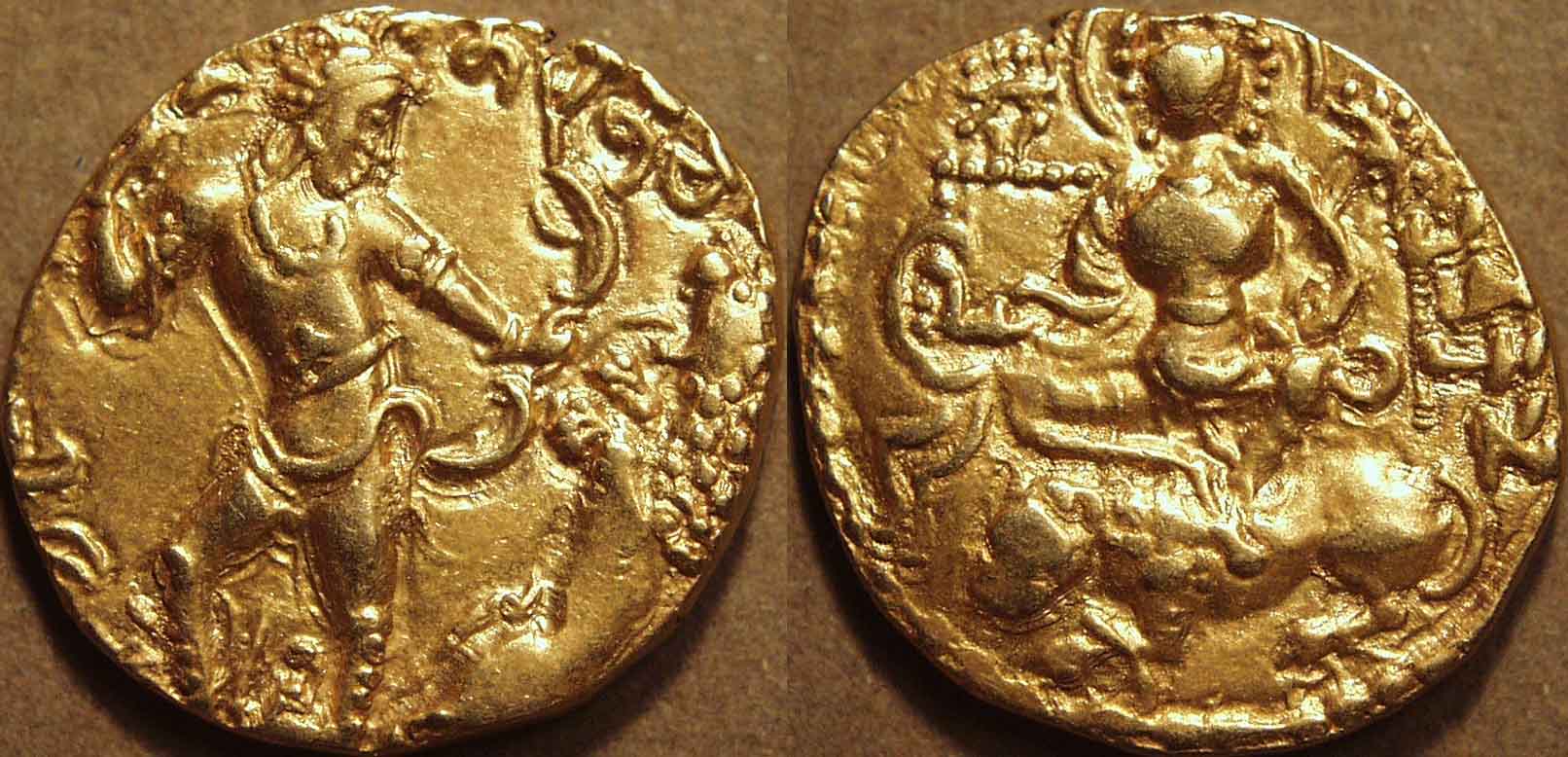
|
Chandragupta II, gold dinar, c. 375-414
Weight: 7.84 gm, Diameter: 20 mm.
King standing right, shooting arrow at lion at right,
circular Brāhmī legend around /
Lakshmi (Durga?) seated facing on lion walking left, holding diadem and cornucopia
Brāhmī legend at right: Simhavikrama
|
 |
The lion-slayer type of Chandragupta II is based on the tiger-slayer type of Samudragupta. This coin must have been
made relatively early in Chandragupta's reign, Note how Lakshmi holds a cornucopia rather than a lotus in her left arm, like in the early archer types. Also, even though she
is seated on a lion rather than a throne, there are the remnants of a throne back behind her.
|

|
Chandragupta II, gold dinar, c. 375-414
Weight: 7.29 gm, Diameter: 19 mm.
King standing right, shooting arrow at lion at right,
circular Brāhmī legend around /
Lakshmi (Durga?) seated facing on couchant lion left, holding diadem
and long-stemmed lotus, Brāhmī legend at right: Simhavikrama
|
 |
This variety replaces Lakshmi's cornucopia with a long-stemmed lotus in her left arm. |

|
Chandragupta II, gold dinar, c. 375-414
Weight: 7.69 gm, Diameter: 20 mm.
King standing right, shooting arrow at lion at right,
circular Brāhmī legend around /
Lakshmi (Durga?) seated left on lion left, holding long-stemmed lotus (?) and ?
Brāhmī legend at right: Simhavikrama
|
 |
An amazing coin of very high artistic quality. Most noticeable is the unusual pose of the goddess on the reverse.
Rather than the usual front-facing pose on a recumbent, static lion, she is here mounted on the lion as if it is a horse and it appears to be charging towards the left with its mouth
agape in a ferocious roar. The whole effect is very dynamic. We see the same sort of dynamism on the obverse as well. Usually the king's pose is rather static, as he stands
straight or even leans away from the lion. But here the king leans forward, pressing his advantage as he tramples the lion under foot and fires an arrow right into its gaping
mouth. |

|
Chandragupta II, gold dinar, c. 375-414
Weight: 7.89 gm, Diameter: 22 mm.
King standing left, shooting arrow at lion at left,
circular Brāhmī legend around /
Lakshmi (Durga?) seated facing on couchant lion left, holding diadem
and long-stemmed lotus, Brāhmī legend at right: Simhavikrama
|
 |
The king here faces to the left. Note his beautiful crown and the wonderful rendition of the lion's face on the reverse.
|

|
Chandragupta II, gold dinar, c. 375-414
Weight: 7.70 gm, Diameter: 20 mm.
King standing left, shooting arrow at lion at left,
circular Brāhmī legend around /
Lakshmi (Durga?) seated facing on lion walking right, holding diadem
and long-stemmed lotus, Brāhmī legend at right: Simhavikrama
|
 |
The lion here appears to be walking to the right ... most unusual!
|
 |
 |
 |
Horseman type |
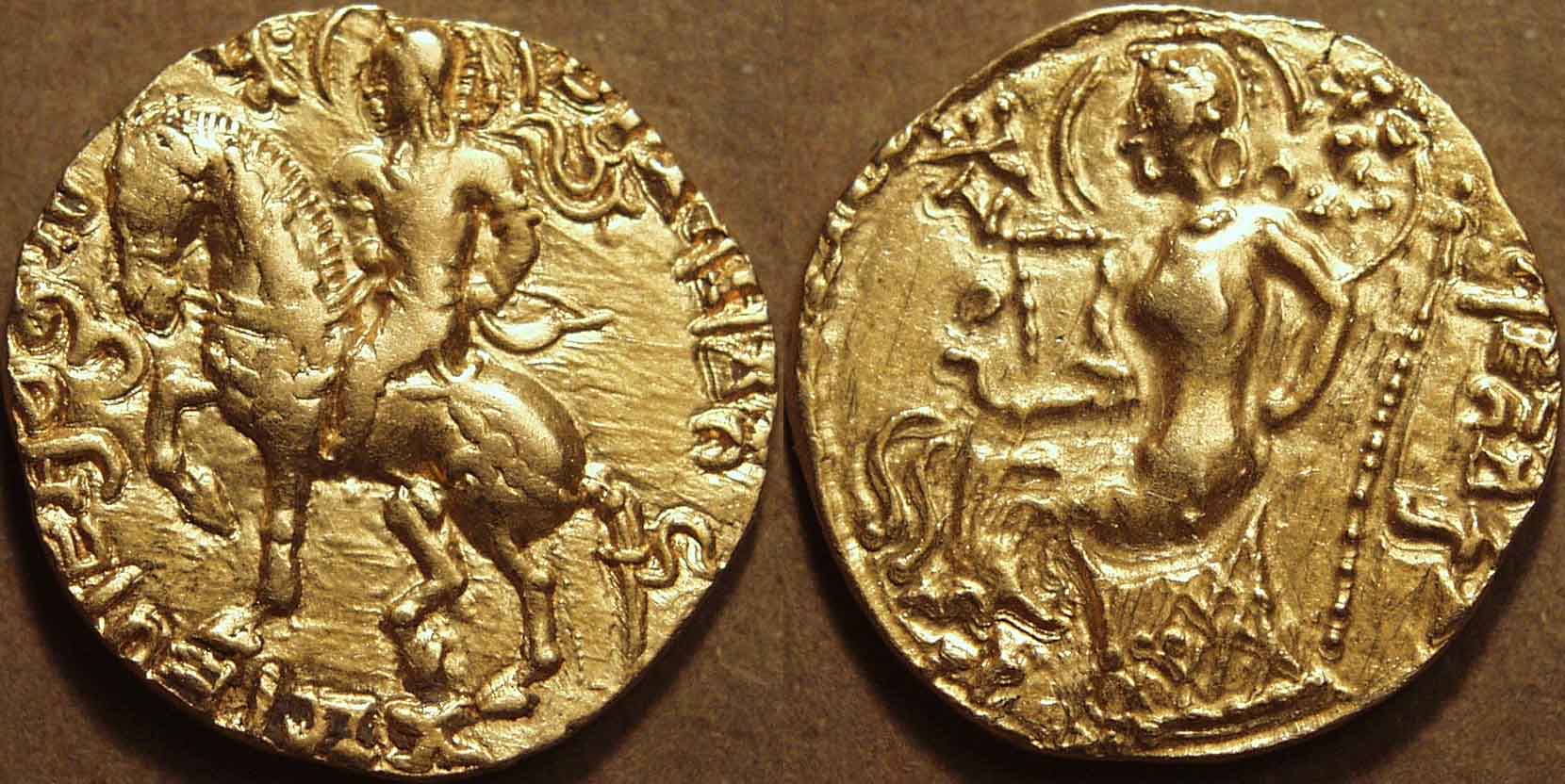
|
Chandragupta II, gold dinar, c. 375-414
Weight: 7.89 gm, Diameter: 21 mm.
King riding horse left,
circular Brāhmī legend around /
Lakshmi seated left on stool, holding diadem and long-stemmed lotus
Brāhmī legend at right: Ajitavikrama
|
 |
The horseman type is a new innovation of Chandragupta II. The coins come with the king facing either left or right. This
coin was probably an early issue since we see the remnants of a throne back (!) behind Lakshmi, even though she is seated on an ornamental stool.
|
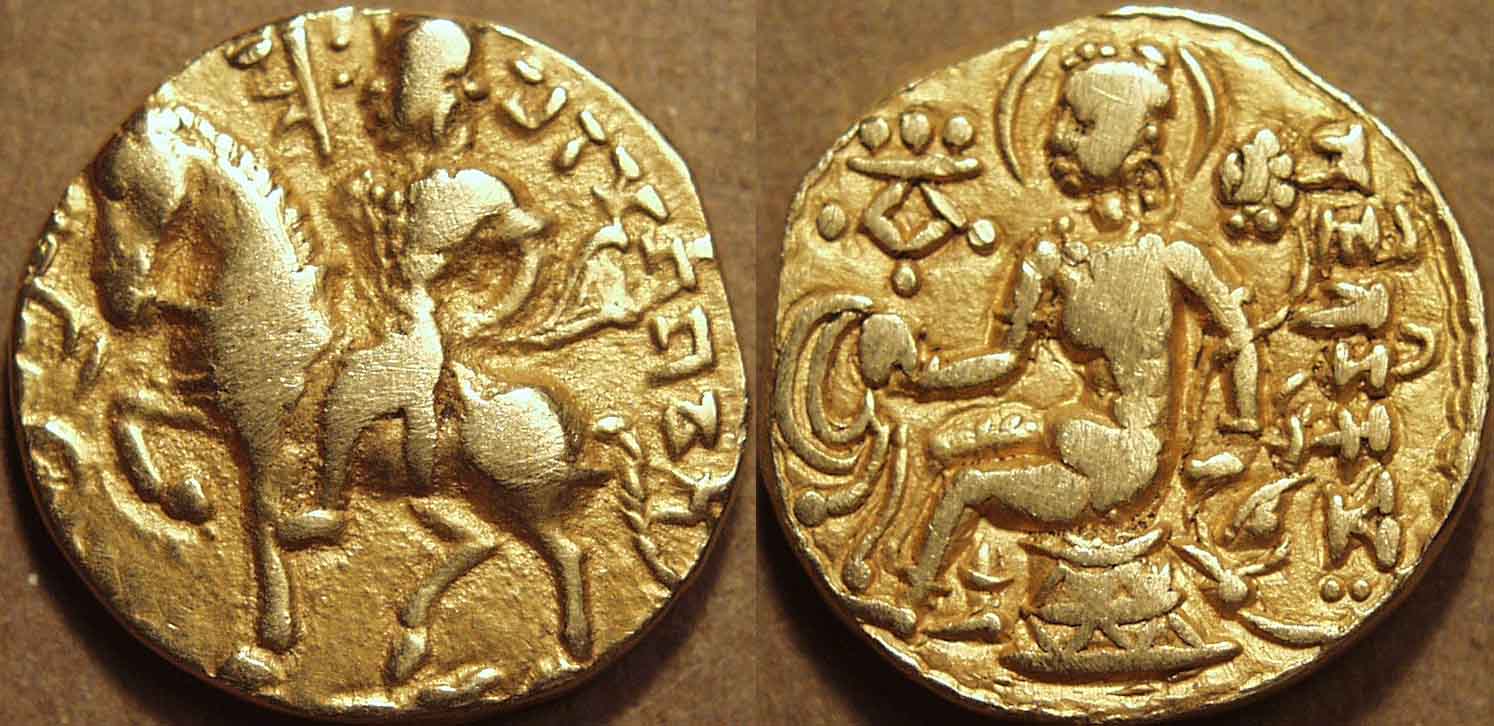
|
Chandragupta II, gold dinar, c. 375-414
Weight: 7.61 gm, Diameter: 19 mm.
King riding horse left,
circular Brāhmī legend around /
Lakshmi seated left on stool, holding diadem and long-stemmed lotus
Brāhmī legend at right: Ajitavikrama
|
 |
On this coin, the throne back behind Lakshmi has disappeared.
|
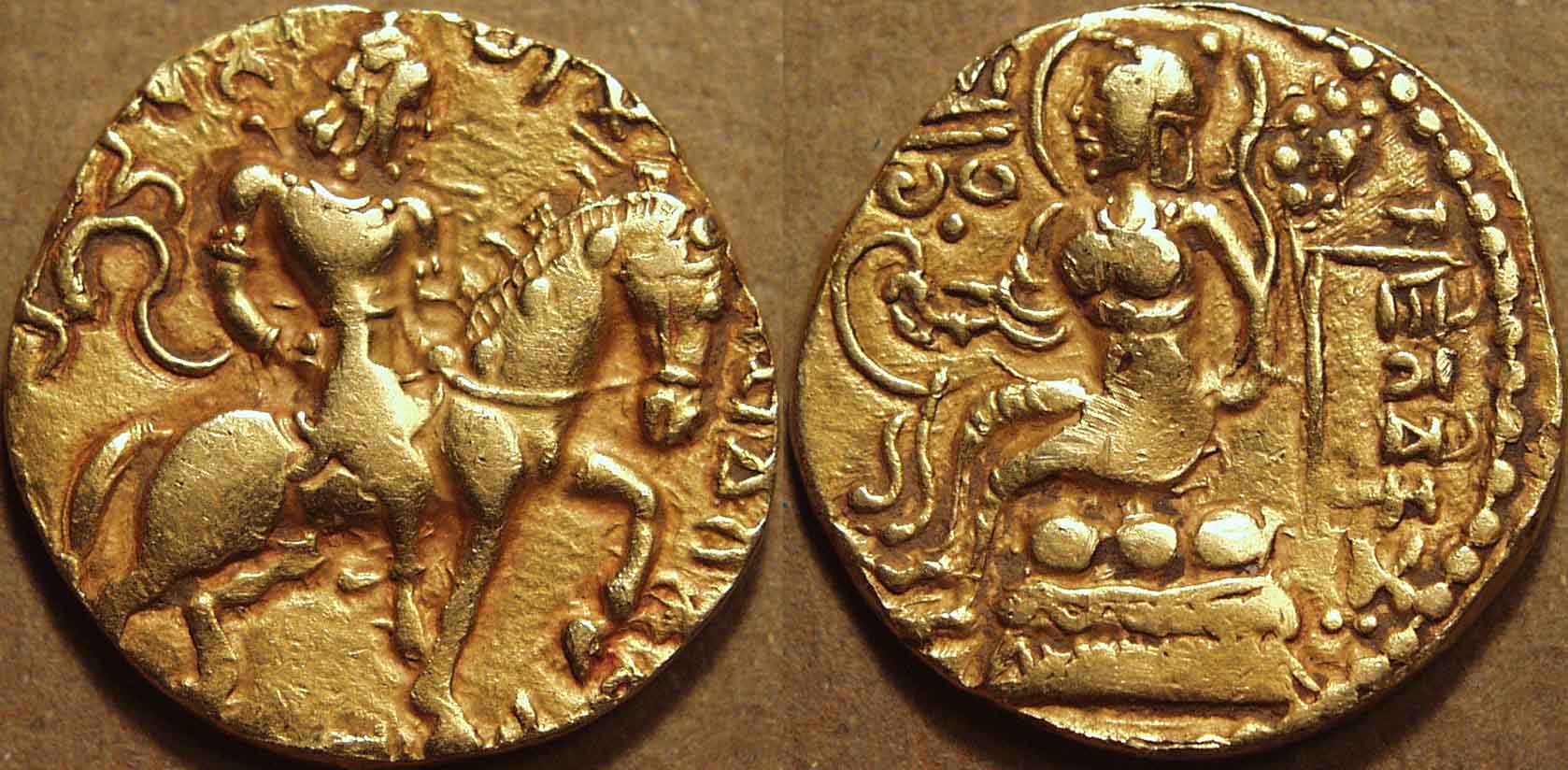
|
Chandragupta II, gold dinar, c. 375-414
Weight: 7.61 gm, Diameter: 21 mm.
King riding horse right,
circular Brāhmī legend around /
Lakshmi seated left on stool, holding diadem and long-stemmed lotus
Brāhmī legend at right: Ajitavikrama
|
 |
Here, the mounted king faces right. Note how the tamgha in the left reverse field has evolved, with beautiful
curled shapes below.
|
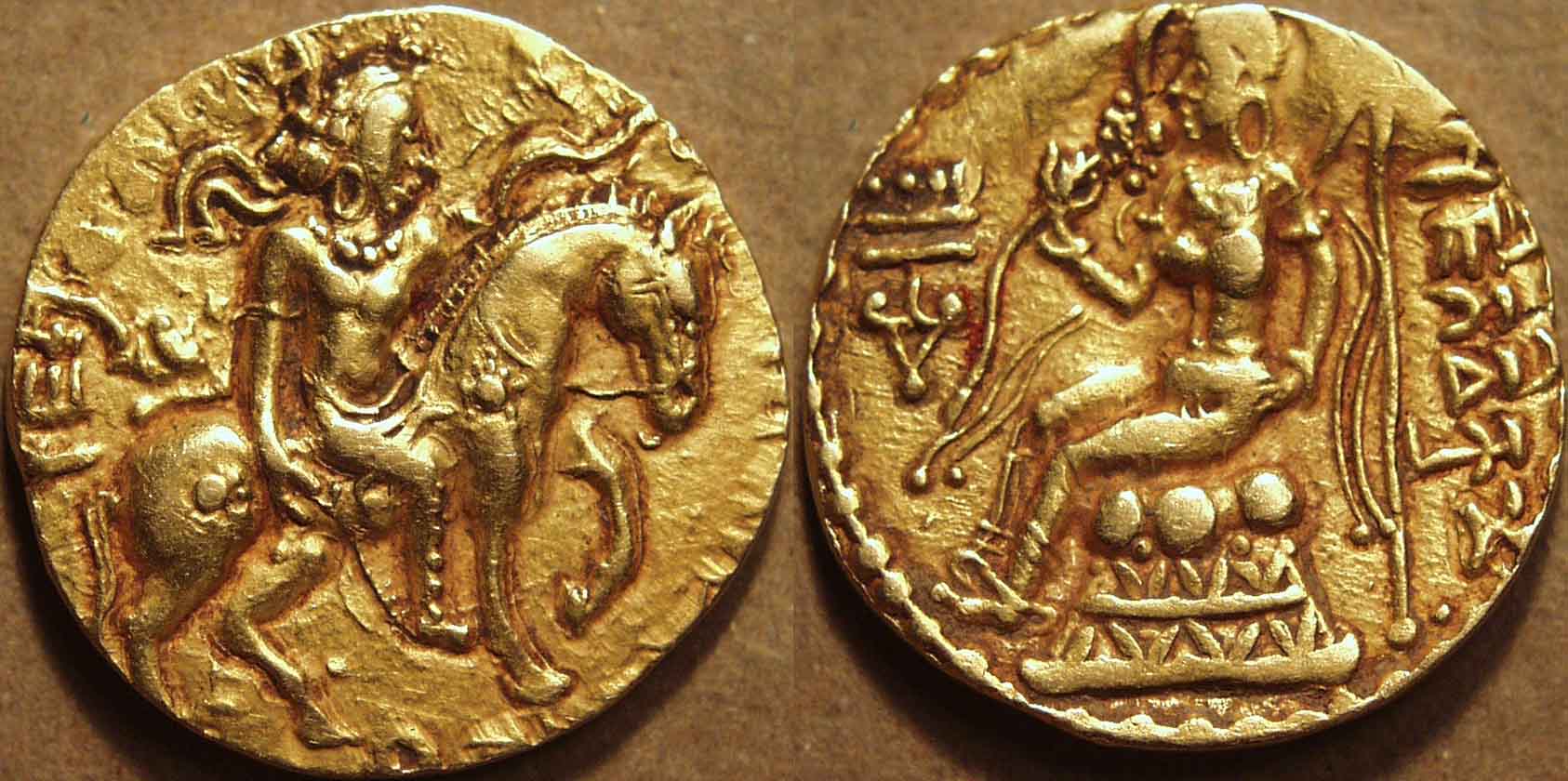
|
Chandragupta II, gold dinar, c. 375-414
Weight: 7.96 gm, Diameter: 21 mm.
King riding horse right,
circular Brāhmī legend around /
Lakshmi seated left on stool, holding long-stemmed lotus
Brāhmī legend at right: Ajitavikrama
|
 |
A beautiful rendition of Lakshmi! The diadem that she normally holds has been discarded and the long-stemmed lotus
has been moved from her left hand to her right. The left hand is now used to lean on the seat of the stool, while the goddess holds the lotus up to her nose to smell its
fragrance.
|
 |
 |
 |
Chhatra type |
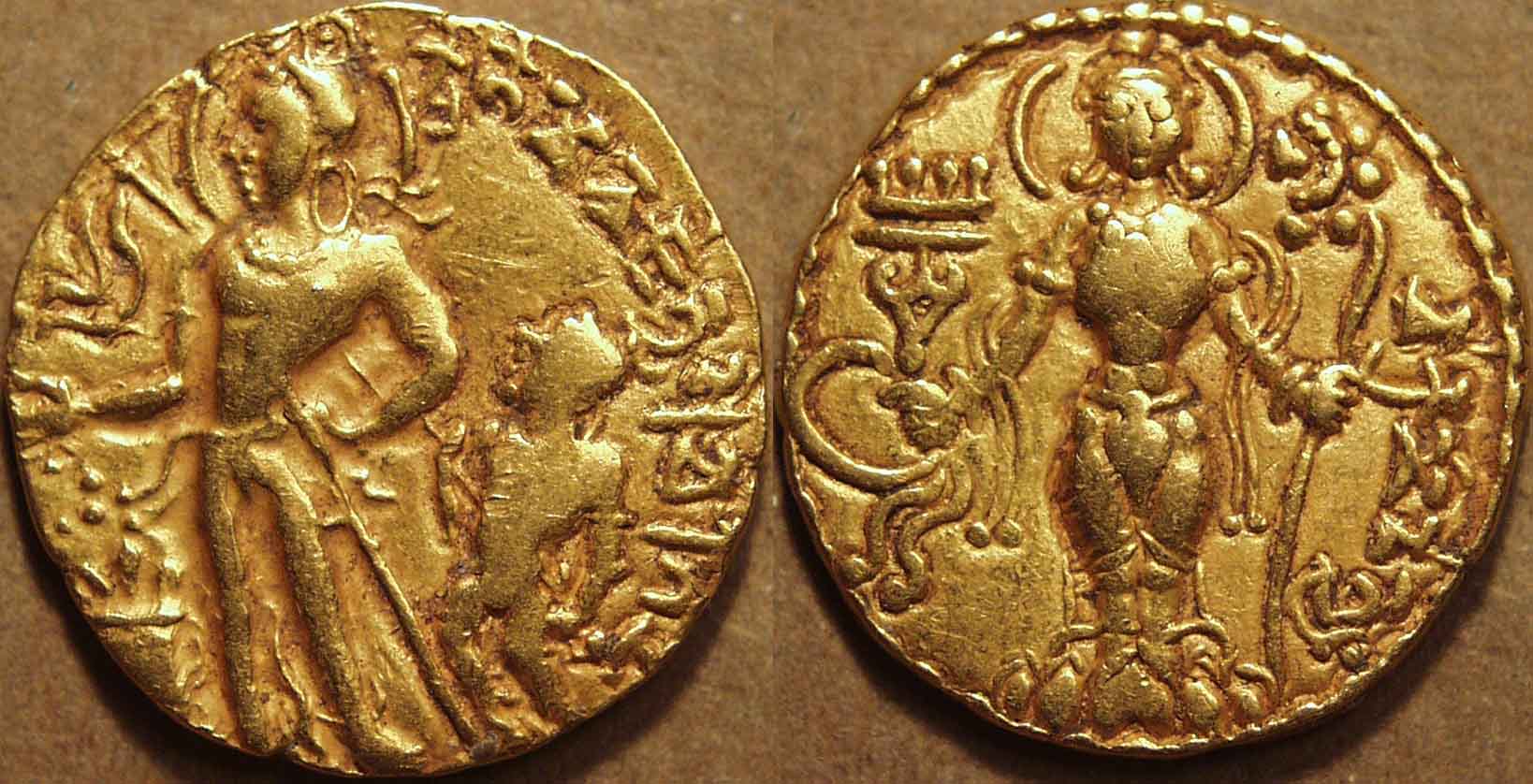
|
Chandragupta II, gold dinar, c. 375-414
Weight: 7.78 gm, Diameter: 20 mm.
King standing left, sacrificing at fire altar at left,
attendant standing at right, holding up a parasol over the king,
circular Brāhmī legend around /
Lakshmi standing on a lotus facing, holding diadem and long-stemmed lotus
Brāhmī legend at right: Vikramāditya
|
 |
The Chhatra or "Royal Parasol" type is another new innovation of Chandragupta II. Note the small size of
the attendant, indicating his inferior position to that of the king. This convention, of using the size of an image to denote the importance of the person represented, is a
standard one in Indian art and can certainly be seen in the much more recent miniature paintings of the Mughal and post-Mughal periods.
|
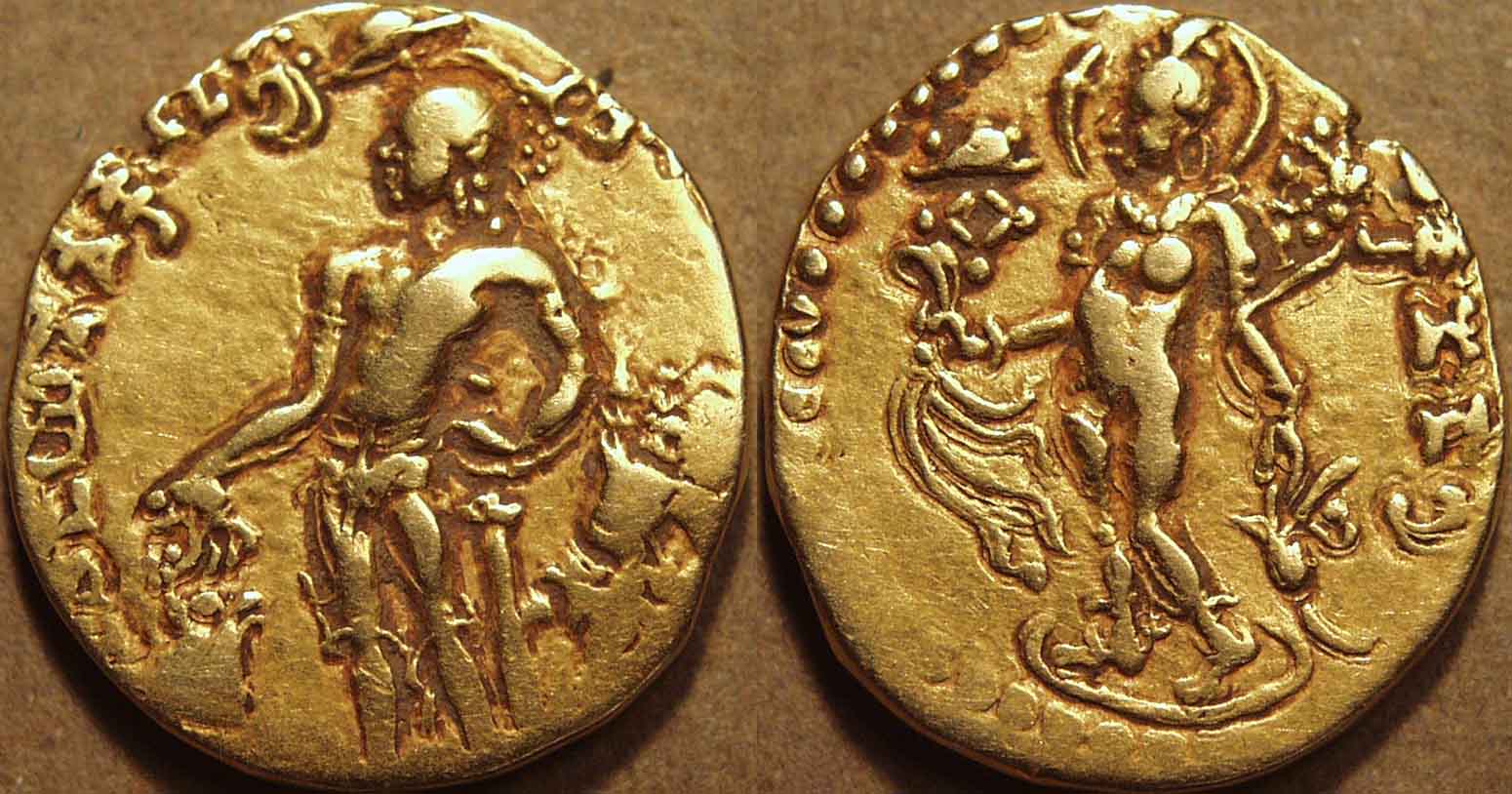
|
Chandragupta II, gold dinar, c. 375-414
Weight: 7.68 gm, Diameter: 19-20 mm.
King standing left, sacrificing at fire altar at left,
attendant standing at right, holding up a parasol over the king,
circular Brāhmī legend around /
Lakshmi walking left holding diadem and long-stemmed lotus
Brāhmī legend at right: Vikramāditya
|
 |
On this variety, Lakshmi is walking towards the left rather than standing facing. Also, note the very clean look of
the obverse. The shaft of the parasol lies behind the king, leaving the left field uncluttered; further, the king here is not nimbate as he normally is, thus further reducing
the clutter on the coin. The result is artistically very pleasing.
|
 |
 |
 |
Couch type |

|
Chandragupta II, gold dinar, c. 375-414
King sitting at ease left, on a couch or throne
circular Brāhmī legend around /
Lakshmi seated left on a low stool,
Brāhmī legend at right: Vikramāditya
|
 |
This type recalls the Lyrist type of Samudragupta.
|
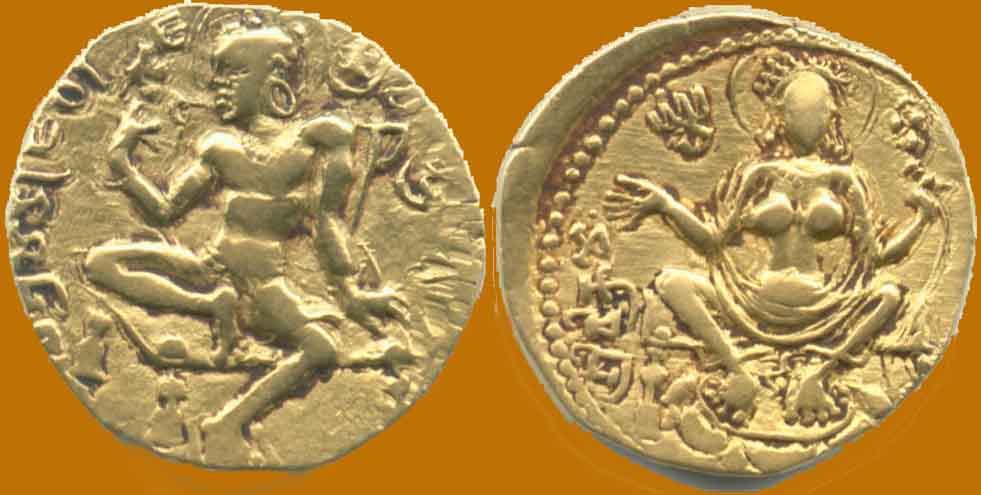
|
Chandragupta II, gold dinar, c. 375-414
King sitting at ease left, on a couch or low stool
circular Brāhmī legend around /
Lakshmi seated facing on a low stool, holding lotus,
Brāhmī legend at right: Vikramāditya
|
 |
A very unusual type in which the king sits on a low stool.
|
 |
 |
| Silver Coins |
Normal type |
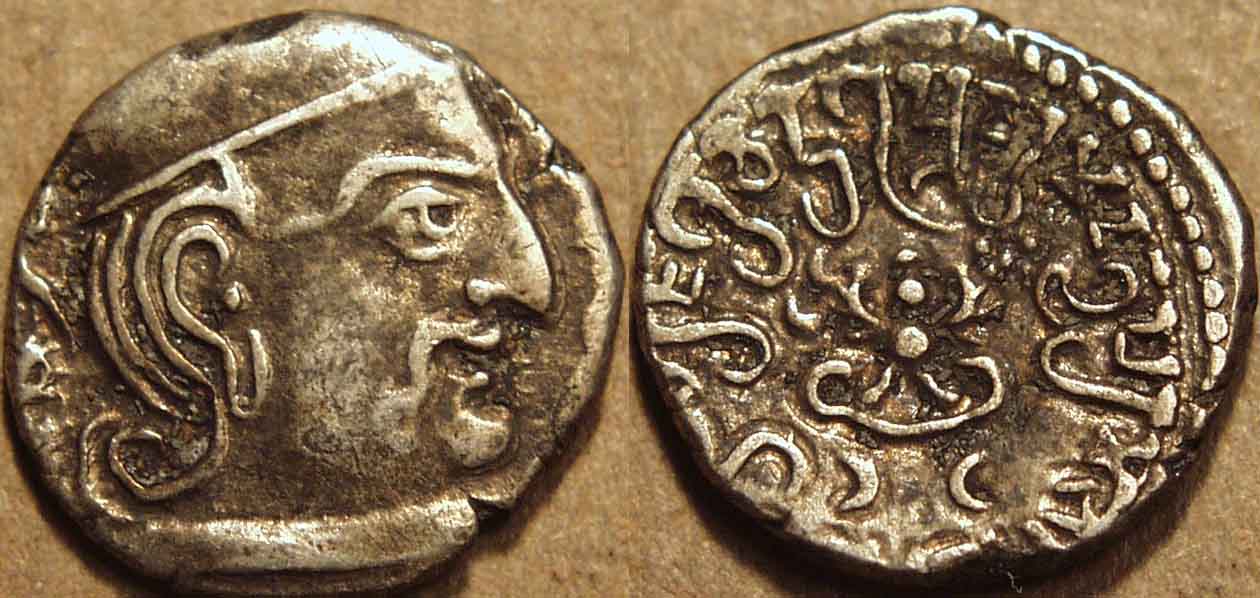
|
Chandragupta II, silver drachma, c. 375-414
Weight: 1.99 gm, Diameter: 14 mm.
Head of king right
remnants of Brāhmī date behind /
Stylized Garuda standing facing, with wings spread,
sun and moon above, Brāhmī legend around:
Paramabhāgavata Maharajadhiraja Sri Chandragupta Vikramāditya
|
 |
The silver coins of Chandragupta II are based on Western Kshatrapa prototypes and mark his annexation of Malwa
and possibly parts of Gujarat at the expense of that dynasty.
|
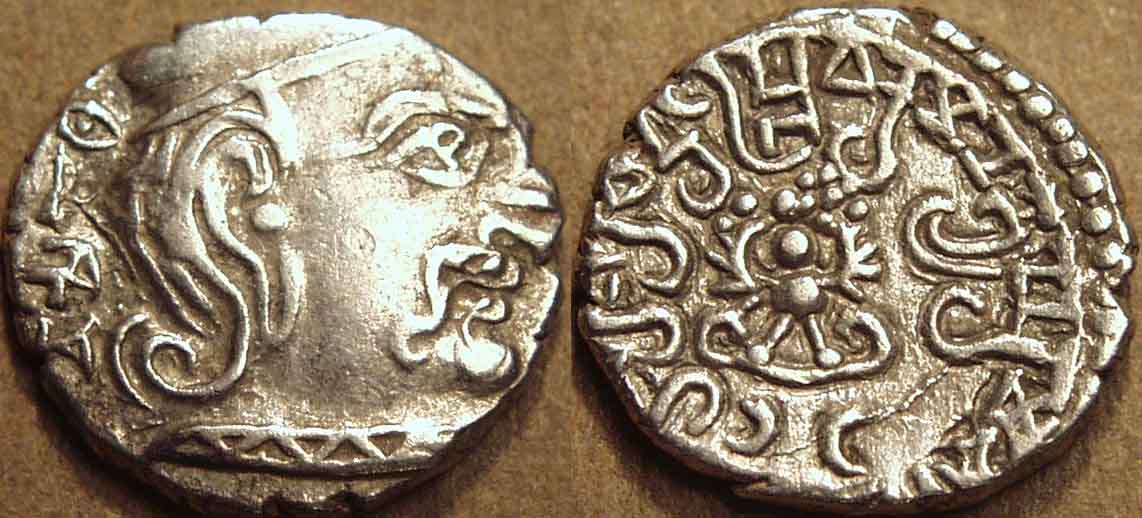
|
Chandragupta II, silver drachma, dated 398 ?
Weight: 2.07 gm, Diameter: 15 mm.
Head of king right
Brāhmī date varshe 320 ? behind /
Stylized Garuda standing facing, with wings spread,
sun and moon above, Brāhmī legend around:
Paramabhāgavata Maharajadhiraja Sri Chandragupta Vikramāditya
|
 |
This coin shows the digits for the year 300 + 20. Although it is possible that there was a units digit on the coin that is
now off the flan, the position of the ten's digit (20) right next to the king's head indicates that there was no number following it. If the year is indeed 320 (Saka era), that would
be equivalent to year 398 CE and would suggest that the conquest of Malwa took place on or before this date.
|
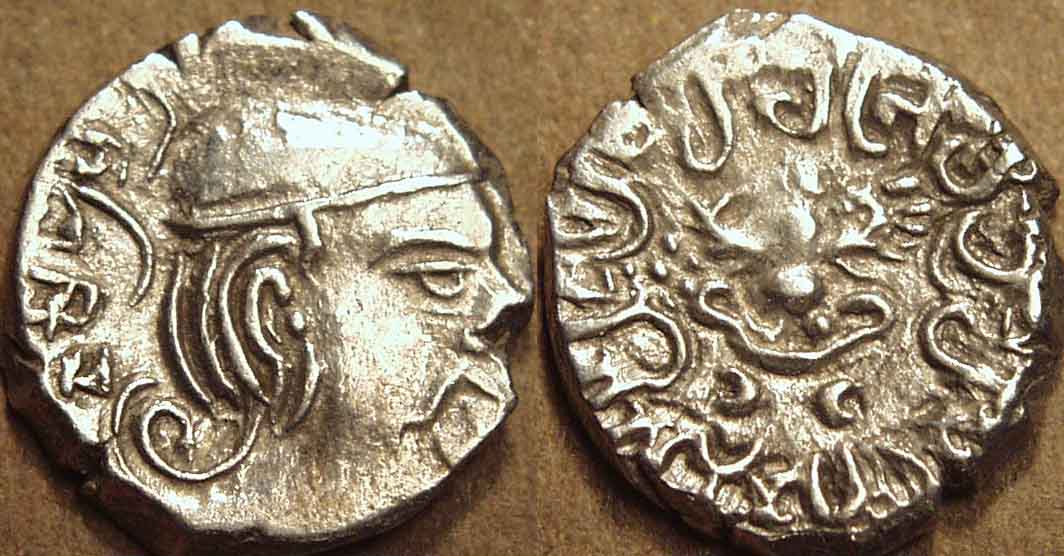
|
Chandragupta II, silver drachma, dated 407
Weight: 2.00 gm, Diameter: 14 mm.
Head of king right
Brāhmī date varshe 329 behind /
Stylized Garuda standing facing, with wings spread,
sun and moon above, Brāhmī legend around:
Paramabhāgavata Maharajadhiraja Sri Chandragupta Vikramāditya
|
 |
This coin shows the digits for the year 300 + 20 + 9, i.e., 329 (Saka era), equivalent to year 407 CE.
|
 |
 |
 |
"Sriguptakula" type |
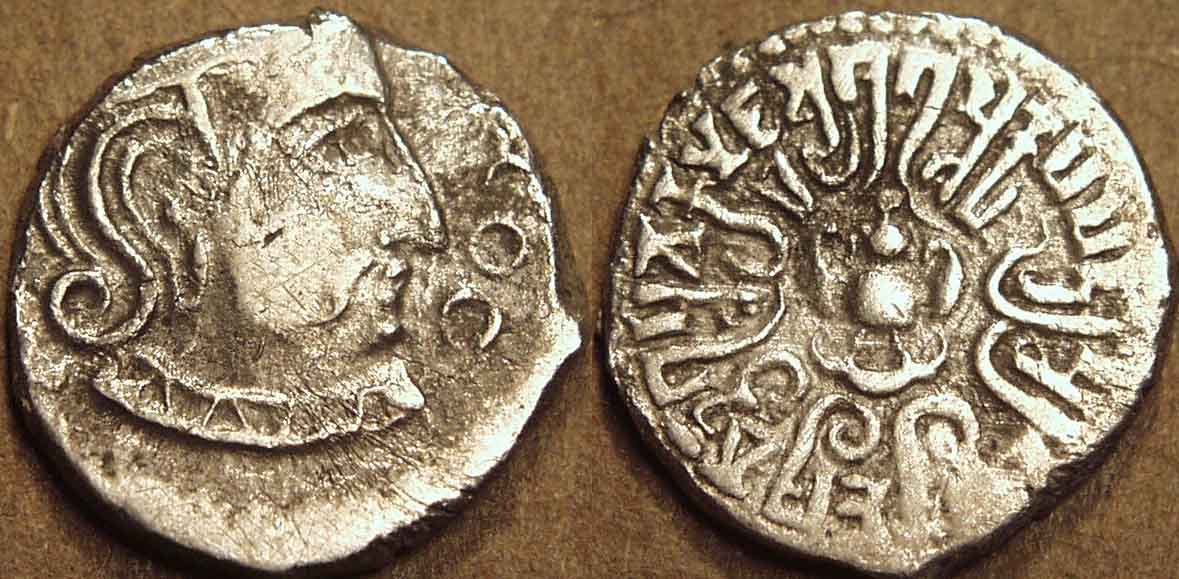
|
Chandragupta II, silver drachma, c. 375-414
Weight: 1.97 gm, Diameter: 15 mm.
Head of king right /
Stylized Garuda standing facing, with wings spread,
Brāhmī legend around:
Sriguptakulālankārasva Rājadhiraja Sri Chandragupta Vikramānkasya
|
 |
This coin and the next are examples of a rare type with an unusual legend, identifying Chandragupta as
belonging to the family (kula) of Sri Gupta. In his article in Numismatic Digest 29-30, Shailendra Bhandare identified the first word in the legend as
Sriguptakulālankārasya, but on both these coins it is quite apparent that the last letter is not sya (compare it to the last letter in
Vikramānkasya). It looks to me like sva. Whether this was intentional or a spelling error on the part of the die-cutter is unclear.
|
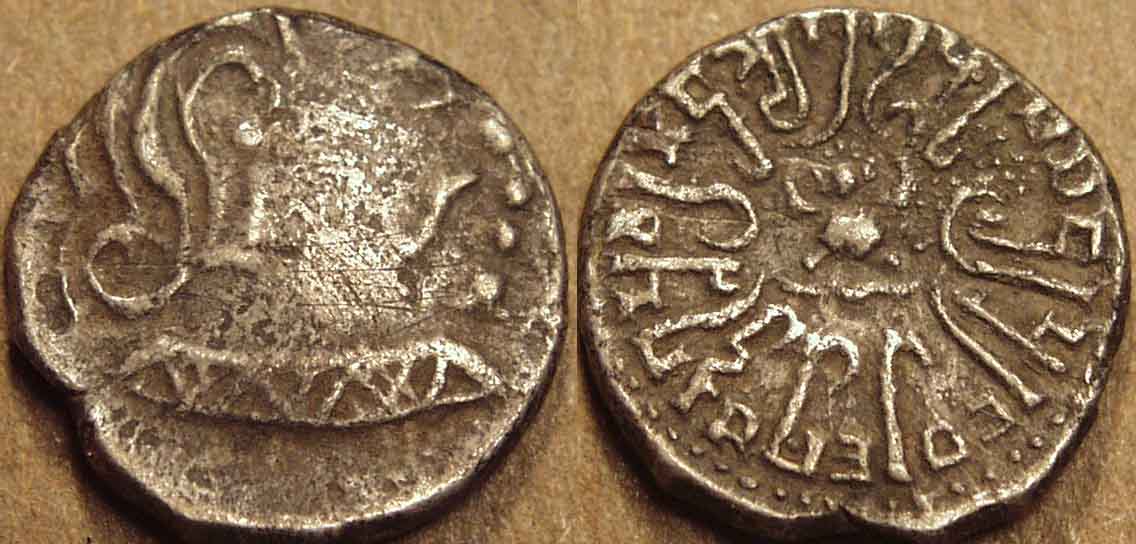
|
Chandragupta II, silver drachma, c. 375-414
Weight: 2.05 gm, Diameter: 14 mm.
Head of king right /
Stylized Garuda standing facing, with wings spread,
Brāhmī legend around:
Sriguptakulālankārasva Rājadhiraja Sri Chandragupta Vikramānkasya
|
 |
Copper and Lead coins |

|
Chandragupta II, c. 375-414, AE fraction
Weight: 1.18 gm., Diam: 13 mm., Die axis = 12 o'clock
King standing left /
Garuda standing facing, Brahmi legend below: Sri Chandragup(ta) |

|
Chandragupta II, c. 375-414, AE unit
Weight: 2.92 gm., Diam: 17-19 mm., Die axis = 1 o'clock
Archer King standing left, Garuda standard left,
Brahmi legend Chandra below arm /
Lakshmi seated on lotus facing
|
 |
This coin may have been the core of a potential ancient forgery of the corresponding gold coin.
|
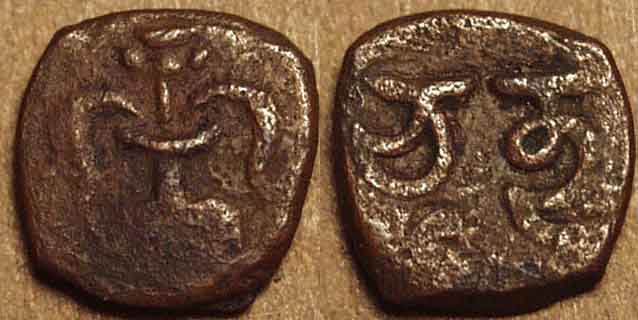
|
Chandragupta II, c. 375-414, AE fraction
Weight: 0.89 gm., Diam: 9.5 mm., Die axis = 12 o'clock
Kalasa (vase) /
Brahmi legend: Chandra |
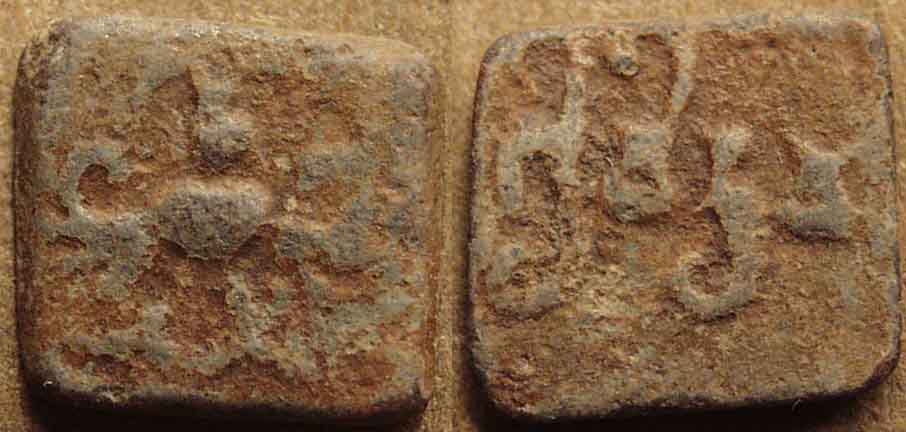
|
Chandragupta II, c. 375-414, Lead unit
Weight: 2.82 gm., Dim: 14 x 13 mm., Die axis = 12 o'clock
Garuda standing facing, with wings outstretched /
Brahmi legend: Sri Vikrama |
|
|